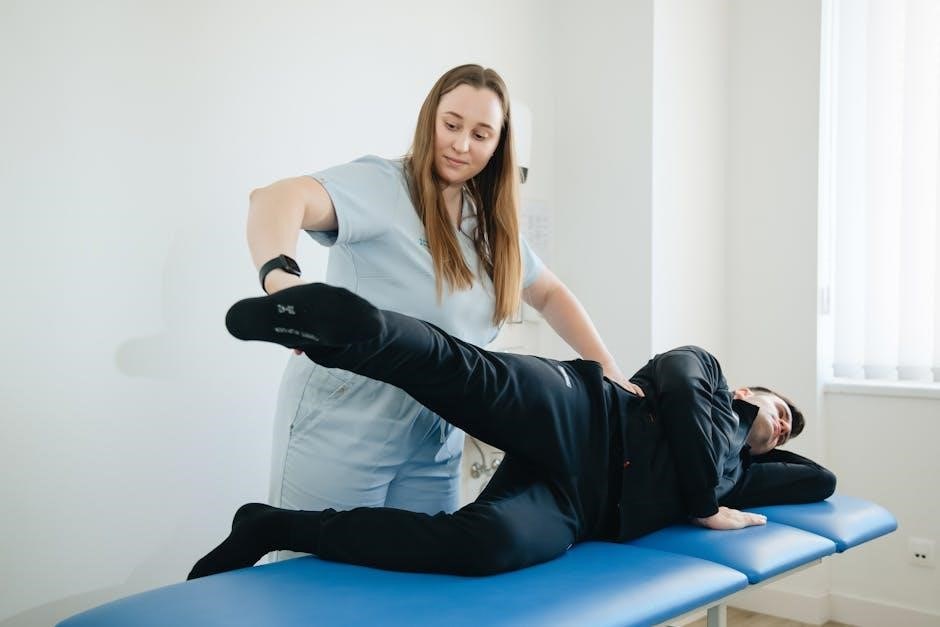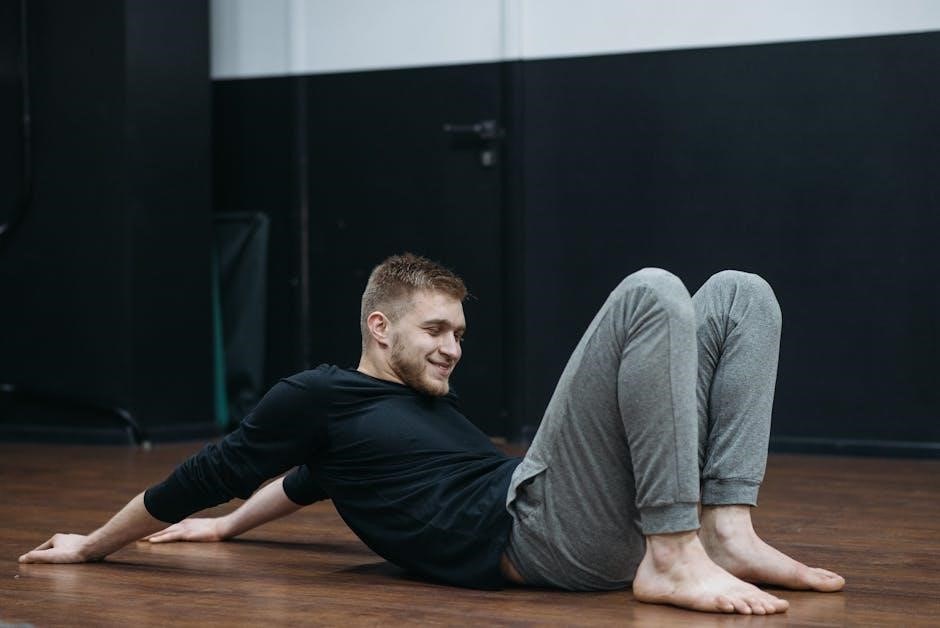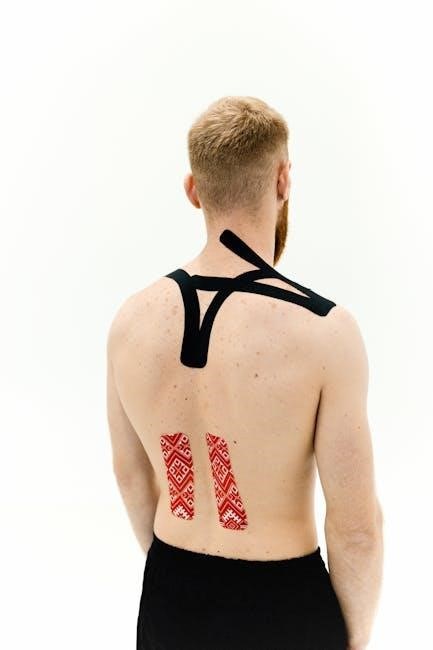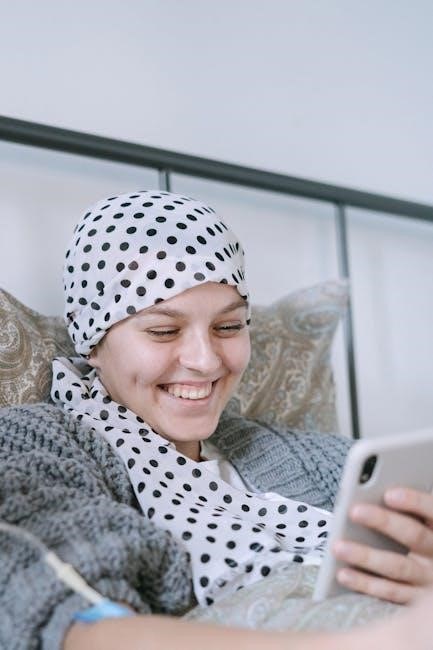femur orif physical therapy protocol pdf
The femur ORIF physical therapy protocol is a treatment plan that helps patients recover from femur fractures‚ using a combination of exercises and physical therapy sessions to regain mobility and strength effectively online․
Importance of Physical Therapy in Recovery
Physical therapy plays a crucial role in the recovery process after femur ORIF surgery‚ helping patients regain mobility‚ strength‚ and function․ A well-structured physical therapy program can significantly reduce the risk of complications and improve overall outcomes․ Through a combination of exercises and physical therapy sessions‚ patients can regain range of motion‚ reduce pain and inflammation‚ and improve their overall quality of life․ The goal of physical therapy is to help patients return to their normal activities as quickly and safely as possible․ By following a comprehensive physical therapy program‚ patients can achieve optimal recovery and regain their independence․ Effective physical therapy can also help patients avoid long-term disability and reduce the need for further surgery or interventions․ With the right physical therapy program‚ patients can make a full recovery and return to their normal activities․ Physical therapy is essential for optimal recovery․
Protocol Overview
The femur ORIF physical therapy protocol is a comprehensive treatment plan that outlines the necessary steps for optimal recovery․ This protocol is designed to guide patients through the different phases of rehabilitation‚ from the initial post-operative period to return to activities․ The protocol takes into account the individual needs and goals of each patient‚ and is tailored to promote safe and effective progress․ A team of healthcare professionals‚ including physical therapists and orthopedic specialists‚ work together to develop and implement the protocol․ The protocol is based on current research and clinical guidelines‚ and is regularly updated to reflect the latest advancements in physical therapy and orthopedic care․ By following this protocol‚ patients can expect to make significant progress and achieve optimal recovery․ The protocol is an essential tool for healthcare professionals‚ providing a clear and comprehensive guide for the treatment of femur ORIF patients․

Phase 1 of Rehabilitation
Initial rehabilitation phase focuses on pain management and wound healing processes online effectively․
Weight-Bearing and Range of Motion Exercises
Weight-bearing and range of motion exercises are crucial components of the rehabilitation protocol‚ aiming to restore functional mobility and strength․ The exercises are designed to promote healing‚ reduce stiffness‚ and improve joint mobility․ Patients are encouraged to perform weight-bearing exercises‚ such as walking‚ to stimulate bone growth and strengthen surrounding muscles․ Range of motion exercises‚ including flexion‚ extension‚ and rotation‚ help maintain joint mobility and prevent contractures․ A physical therapist will guide patients through these exercises‚ providing feedback and adjustments to ensure proper technique and progression․ The goal is to gradually increase weight-bearing and range of motion‚ allowing patients to regain independence and return to daily activities․ By incorporating these exercises into the rehabilitation protocol‚ patients can expect significant improvements in functional mobility and overall recovery․ Regular physical therapy sessions will monitor progress and address any concerns or limitations․
Physical Therapy Sessions
Physical therapy sessions play a vital role in the rehabilitation process‚ providing patients with personalized guidance and support․ A physical therapist will work closely with patients to develop a tailored treatment plan‚ addressing specific needs and goals․ During these sessions‚ patients will learn how to perform exercises correctly‚ receive feedback on technique‚ and have any concerns or questions addressed․ The physical therapist will also monitor progress‚ making adjustments to the treatment plan as needed to ensure optimal recovery․ Regular physical therapy sessions will help patients stay motivated and engaged in the rehabilitation process‚ ultimately achieving a successful outcome․ By attending these sessions‚ patients can expect to receive expert care and guidance‚ facilitating a safe and effective return to functional activities․ The frequency and duration of physical therapy sessions will vary depending on individual needs and progress․ A physical therapist will work to create a supportive and encouraging environment․

Phase 2 of Rehabilitation
Phase 2 involves progressing exercises and activities to further improve strength and mobility online effectively․
Progressing Weight-Bearing and Range of Motion
The goal of this phase is to progress weight-bearing and range of motion exercises to improve mobility and strength․ Patients are encouraged to gradually increase their weight-bearing activities‚ such as walking and standing‚ while also progressing their range of motion exercises to improve flexibility and mobility․ This can be achieved through a combination of physical therapy sessions and home exercises․ The physical therapist will work with the patient to develop a personalized exercise program that meets their specific needs and goals․ The program will include a range of exercises‚ such as squats‚ lunges‚ and leg presses‚ to improve strength and mobility․ The patient will also be taught how to use assistive devices‚ such as canes or walkers‚ to help with mobility and balance․ By progressing weight-bearing and range of motion exercises‚ patients can improve their overall function and mobility․
Advancing to Phase 2 Therapy
Advancing to phase 2 therapy is a crucial step in the rehabilitation process‚ where patients transition from initial post-operative care to more advanced exercises and activities․ This phase typically occurs when the patient has achieved a certain level of healing and mobility‚ as determined by their physical therapist and physician․ The decision to advance to phase 2 therapy is based on the patient’s progress‚ pain levels‚ and ability to perform specific exercises and activities․ The physical therapist will assess the patient’s strength‚ range of motion‚ and functional abilities to determine if they are ready to progress to more challenging exercises․ By advancing to phase 2 therapy‚ patients can expect to see significant improvements in their mobility‚ strength‚ and overall function‚ ultimately achieving their rehabilitation goals and returning to their normal activities․ This phase is critical in ensuring a successful recovery and preventing complications․

Phase 3 of Rehabilitation
Phase 3 focuses on advanced strengthening and functional exercises to restore optimal function and mobility online effectively․
Continuing Progression of Weight-Bearing and Range of Motion
The progression of weight-bearing and range of motion exercises is crucial in phase 3 of rehabilitation․ Patients are encouraged to continue advancing their weight-bearing status‚ gradually increasing the amount of weight they put on their affected leg․ This can be achieved through various exercises‚ such as squats‚ lunges‚ and step-ups․ The range of motion exercises should also be continued‚ with a focus on improving flexibility and mobility․ Patients should aim to achieve a full range of motion in their hip joint‚ including flexion‚ extension‚ abduction‚ and adduction․ A physical therapist can help design a personalized exercise program to ensure a safe and effective progression of weight-bearing and range of motion․ By continuing to progress these exercises‚ patients can improve their overall functional ability and reduce their risk of future complications․ Regular follow-up appointments with a physical therapist are necessary to monitor progress․
Return to Activities
The final goal of the rehabilitation protocol is to return patients to their previous level of activity․ This can include daily activities‚ such as walking‚ climbing stairs‚ and performing household chores‚ as well as recreational activities‚ like jogging‚ cycling‚ or swimming․ A physical therapist can help patients progress to more advanced activities‚ such as agility drills and balance exercises‚ to improve their overall functional ability․ Patients should be able to return to their normal activities without experiencing significant pain or discomfort․ It is essential to follow a gradual and progressive approach to avoid overloading the affected hip joint․ By returning to activities gradually‚ patients can reduce their risk of future complications and improve their overall quality of life․ A physical therapist can provide guidance and support throughout the return to activities process‚ ensuring a safe and successful outcome․ Regular follow-up appointments are necessary to monitor progress․

Rehabilitation Guidelines
Rehabilitation guidelines provide a framework for physical therapists to follow during treatment‚ ensuring optimal recovery and minimizing complications effectively using online resources and protocols available․
Hip Pinning or ORIF Guideline
The hip pinning or ORIF guideline is a crucial component of the rehabilitation process‚ outlining specific instructions for physical therapists to follow during treatment․ This guideline is designed to ensure optimal recovery and minimize complications‚ taking into account the individual patient’s needs and progress․ According to the guideline‚ patients should be monitored closely for any signs of complications‚ such as infection or hardware failure․ The guideline also provides recommendations for wound care‚ pain management‚ and follow-up appointments․ By following this guideline‚ physical therapists can help patients achieve a successful recovery and return to their normal activities․ The guideline is typically developed in consultation with orthopedic surgeons and other healthcare professionals‚ ensuring that it is based on the latest research and best practices․ Overall‚ the hip pinning or ORIF guideline plays a vital role in the rehabilitation process‚ helping patients achieve optimal outcomes․
Wound Check and Follow-Up
The wound check and follow-up are essential components of the rehabilitation process‚ ensuring that the surgical site is healing properly and that any potential complications are identified early․ Physical therapists play a crucial role in monitoring the wound and reporting any concerns to the orthopedic surgeon․ The follow-up appointments provide an opportunity for the surgeon to assess the patient’s progress‚ remove any sutures or staples‚ and provide guidance on further treatment․ During these appointments‚ the surgeon will also check for any signs of infection‚ such as redness‚ swelling‚ or increased pain․ The wound check and follow-up appointments are typically scheduled at regular intervals‚ such as one week‚ two weeks‚ and six weeks after surgery․ By closely monitoring the wound and addressing any concerns promptly‚ physical therapists and orthopedic surgeons can help patients achieve a smooth and successful recovery․ Regular follow-up appointments are necessary to ensure optimal outcomes․

